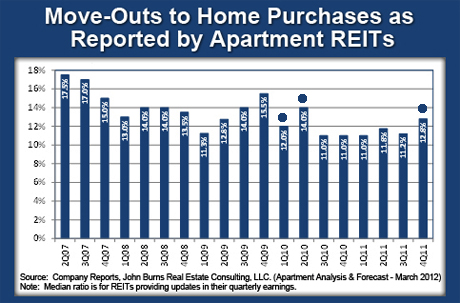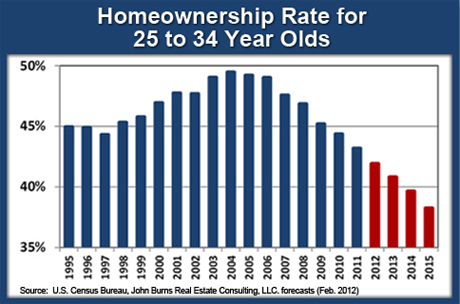Real Estate Market
More renters becoming first time home-buyers, but most 'boomerang' back to parents
by Broderick Perkins
(4/9/2012) In another sign of the housing recovery times, the trend of renters moving out to own homes is picking up speed at a pace not seen in 18 months.
Unfortunately, homeownership rates are shrinking among those at the first-time home buying age.
That signals what's likely to be spotty housing recovery.
Among renters moving out of apartments held in apartment real estate investment trusts (REITs), nearly 13 percent of them were moving out to buy (MOTB) a home in the fourth quarter 2011, according to John Burns Real Estate Consulting.
That's as high as the MOTB ratio has been since the second quarter of 2010 when the share was 14 percent.
"The housing market is carving out a bottom and renters are slowly starting to purchase homes again," notes Rick Palacios Jr. a senior research analyst at John Burns.
Renters' MOTB ratio varies by location from a low of 5 to 6 percent in expensive California and New York markets to a high of 21 percent in more affordable markets, including Phoenix, AZ.

Renters motivated to buy
Credit rising rents, more affordable housing and record low interest rates for the shift toward the larger MOTB ratio.
Late last year, based on its database of large apartment complexes, RealFacts reported the rental market had hit a new stride, returning to pre-recession territory with average rents, at $994 a month, on par with the average $997 a month when the rental market last peaked back in the third quarter of 2008.
Unfortunately, the market shift is pushing rental costs ahead of the cost of owning a home.
Since 1985, homeowners have increased their housing expenditure allocation by 12 percent, while renters increased by 22 percent, according to CoreLogic.
As of 2010, homeowners were spending 33.2 percent of their expenditures on housing, up from 31.9 percent in 2005. Renters spent 38.4 percent of their expenditures on housing, up from 35.6 percent in 2005, CoreLogic reported.
It's no wonder renters are bailing.
Unfortunately, the upward trend in renters MOTB hasn't been consistent and that makes the trend's sustainability questionable.
Since the last high 14 percent MOTB ratio in second quarter of 2010, the ratio slipped to 11 percent the following quarter where it where it remained mired for three quarters, through the first quarter of 2011. The ratio bounced up and then down again before moving up to 12.8 percent by the end of 2011.
"The motivation for renters to buy is obvious, as affordability is phenomenal and apartment REITs continue to push rent renewals as high as 10 percent to 15 percent in some markets. The real question is, 'How many renters qualify for a mortgage?' " Palacios asked.
First-time buyer age group floundering
About 30 percent of home sales go to first-timers, many of whom are former renters, but that level is far off peak, 2009 levels. For example, the current homeownership rate among 25 to 34 year-olds, typically first-time home buyers, is down from a peak of nearly 50 percent in 2004 to about 43 percent last year, according to John Burns.
Burns projects that rate to continue to fall, down as low as 38 percent by 2015, because a larger share of renters moving out of apartments are buying time, not a home.

Young shelter-seekers have been dubbed the "boomerang generation" because of their penchant for fleeing the nest during good times, but making a bee-line back when times get tough.
Pew Research says among adults aged 25 to 29, 41 percent live with mom and pop due to the economy. The same is true for 17 percent of those aged 30 to 34 year old.
John Burns' 2012 Consumer Insights survey of more than 20,000 respondents found that more than 70 percent of respondents are considering accommodating extended family in their next home purchase and 19 percent said they will accommodate an extended family member, in both cases, including children 18 years of age and older.
While the current trend shows an increased number of renters moving out to buy homes, the age group has a long way to go before they represent the homeownership share they held in 2009.
"Due to a combination of factors (lingering mortgage distress, lackluster economic growth, and stringent lending), we expect the homeownership rate for 25 to 34 year olds to continue falling through 2015. Subsequently, we anticipate that over 8 million renter households will be added from 2010 to 2015, more than double the amount of renters added from 2000 to 2010," Palacios predicted.
Refinance at Today's Low Rates!
Follow the link to continue reading the related articles
New FHA Rule May Reduce Borrowing, Hurt Housing Market
More short sale investors help fuel housing recovery
Zillow experts' do-over retreats from past housing forecast
Burns Consulting: Lagging indicators may have cost buyers bottom-market buys
Should you be buying or renting your home?
How to offset the rising cost of rent
Home ownership beats renting, if you can get a loan
Fannie Mae & Jumbo Mortgage Rates
Just One Click! = Current Rate Chart


